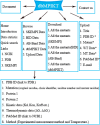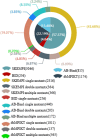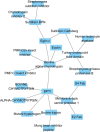dbMPIKT: a database of kinetic and thermodynamic mutant protein interactions
- PMID: 30482172
- PMCID: PMC6260753
- DOI: 10.1186/s12859-018-2493-7
dbMPIKT: a database of kinetic and thermodynamic mutant protein interactions
Abstract
Background: Protein-protein interactions (PPIs) play important roles in biological functions. Studies of the effects of mutants on protein interactions can provide further understanding of PPIs. Currently, many databases collect experimental mutants to assess protein interactions, but most of these databases are old and have not been updated for several years.
Results: To address this issue, we manually curated a kinetic and thermodynamic database of mutant protein interactions (dbMPIKT) that is freely accessible at our website. This database contains 5291 mutants in protein interactions collected from previous databases and the literature published within the last three years. Furthermore, some data analysis, such as mutation number, mutation type, protein pair source and network map construction, can be performed online.
Conclusion: Our work can promote the study on PPIs, and novel information can be mined from the new database. Our database is available in http://DeepLearner.ahu.edu.cn/web/dbMPIKT/ for use by all, including both academics and non-academics.
Keywords: Kinetic data; Mutants; Protein-protein interactions; Thermodynamic data.
Conflict of interest statement
Ethics approval and consent to participate
Not applicable.
Consent for publication
Not applicable.
Competing interests
The authors declare that they have no competing interests.
Publisher’s Note
Springer Nature remains neutral with regard to jurisdictional claims in published maps and institutional affiliations.
Figures
Similar articles
-
IIIDB: a database for isoform-isoform interactions and isoform network modules.BMC Genomics. 2015;16 Suppl 2(Suppl 2):S10. doi: 10.1186/1471-2164-16-S2-S10. Epub 2015 Jan 21. BMC Genomics. 2015. PMID: 25707505 Free PMC article.
-
Applications of Protein Thermodynamic Database for Understanding Protein Mutant Stability and Designing Stable Mutants.Methods Mol Biol. 2016;1415:71-89. doi: 10.1007/978-1-4939-3572-7_4. Methods Mol Biol. 2016. PMID: 27115628
-
SKEMPI: a Structural Kinetic and Energetic database of Mutant Protein Interactions and its use in empirical models.Bioinformatics. 2012 Oct 15;28(20):2600-7. doi: 10.1093/bioinformatics/bts489. Epub 2012 Aug 1. Bioinformatics. 2012. PMID: 22859501
-
Thermodynamic databases for proteins and protein-nucleic acid interactions.Biopolymers. 2001-2002;61(2):121-6. doi: 10.1002/1097-0282(2002)61:2<121::AID-BIP10077>3.0.CO;2-1. Biopolymers. 2001. PMID: 11987161 Review.
-
Prediction of protein stability upon point mutations.Biochem Soc Trans. 2007 Dec;35(Pt 6):1569-73. doi: 10.1042/BST0351569. Biochem Soc Trans. 2007. PMID: 18031268 Review.
Cited by
-
Persistent Laplacian projected Omicron BA.4 and BA.5 to become new dominating variants.Comput Biol Med. 2022 Dec;151(Pt A):106262. doi: 10.1016/j.compbiomed.2022.106262. Epub 2022 Nov 2. Comput Biol Med. 2022. PMID: 36379191 Free PMC article.
-
Binding Curve Viewer: Visualizing the Equilibrium and Kinetics of Protein-Ligand Binding and Competitive Binding.J Chem Inf Model. 2024 May 27;64(10):4180-4192. doi: 10.1021/acs.jcim.4c00130. Epub 2024 May 8. J Chem Inf Model. 2024. PMID: 38720179 Free PMC article.
-
SAAMBE-3D: Predicting Effect of Mutations on Protein-Protein Interactions.Int J Mol Sci. 2020 Apr 7;21(7):2563. doi: 10.3390/ijms21072563. Int J Mol Sci. 2020. PMID: 32272725 Free PMC article.
-
Revealing the Threat of Emerging SARS-CoV-2 Mutations to Antibody Therapies.J Mol Biol. 2021 Sep 3;433(18):167155. doi: 10.1016/j.jmb.2021.167155. Epub 2021 Jul 14. J Mol Biol. 2021. PMID: 34273397 Free PMC article.
-
Hot spot prediction in protein-protein interactions by an ensemble system.BMC Syst Biol. 2018 Dec 31;12(Suppl 9):132. doi: 10.1186/s12918-018-0665-8. BMC Syst Biol. 2018. PMID: 30598091 Free PMC article.
References
-
- Hu G, Xiao F, Li Y, Li Y, Vongsangnak W. Protein-protein Interface and disease: perspective from biomolecular networks. Adv Biochem Eng Biotechnol. 2017;160:57–74. - PubMed
-
- Zarei O, Hamzeh-Mivehroud M, Benvenuti S, Ustun-Alkan F, Dastmalchi S. Characterizing the hot spots involved in RON-MSP complex formation using in silico alanine scanning mutagenesis and molecular dynamics simulation. Advanced pharmaceutical bulletin. 2017;7:141–150. doi: 10.15171/apb.2017.018. - DOI - PMC - PubMed
MeSH terms
Substances
Grants and funding
LinkOut - more resources
Full Text Sources





